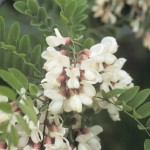Black Locust
Robinia pseudo-acacia
Fabaceae (Legume family)
Description
Black locust is an introduced tree up to 50 feet tall that often forms colonies by root sprouts. Spines on the young stems are unbranched and resemble large rose thorns. Seven to 19 oval leaflets are arranged opposite with the entire leaf up to 6 inches long.
The fragrant, abundant flowers have white petals and a banner with a yellowish center and are arranged in hanging clusters 4 to 8 inches long. The pods are flat, thin and brown and may persist through the winter.
Habitat
Black locust is extensively planted in shelterbelts and as an ornamental. It can be found in all areas of Texas except the Rolling Plains and the Trans-Pecos. It is probably native to the southeastern United States.
Toxic Agent
The toxic agent of black locust is robin, a protein toxin. All parts of the plant except the flower are toxic.
Horses, cattle, sheep and poultry have been poisoned.
Horses are most often poisoned and are the most susceptible species. Horses that consumed as little as 0.04 percent of their weight in bark showed signs of poisoning in 1.5 hours.
Signs of Livestock Ingestion
Signs of poisoning are similar in all species and may include: Anorexia; Depression; Diarrhea; Weakness (posterior paralysis in cattle and horses); Cold extremities; Weak pulse; Irregular heartbeat.
In fatal cases, death usually occurs within 1 or 2 days.
Management Strategies
Most clinically affected animals recover after removal from the source. However, complete recovery may take several weeks, and horses often founder or develop laminitis. Do not place horses in a paddock with a black locust tree. Boredom may cause them to consume the leaves or strip the bark from the trees.
Images
Plant Characteristics
Flower Color: White
Seed Type: Bean/Pod
Duration: Perennial
Stem Texture: Prickly, Spiny, or Thorny
Growth Habit: Shrub (Woody)
Leaf Shape
 : Pinnately Compound
: Pinnately Compound
Season: Warm
Distribution
 : 01 - Pineywoods, 02 - Gulf Prairies and Marshes, 03 - Post Oak Savannah, 04 - Blackland Prairies, 05 - Cross Timbers and Prairies, 06 - South Texas Plains, 07 - Edwards Plateau, 09 - High Plains
: 01 - Pineywoods, 02 - Gulf Prairies and Marshes, 03 - Post Oak Savannah, 04 - Blackland Prairies, 05 - Cross Timbers and Prairies, 06 - South Texas Plains, 07 - Edwards Plateau, 09 - High Plains
Distributions
Distribution refers to the ecological region in Texas that a plant has been found. You can also view a clickable map.
Book: Toxic Plants of Texas (B-6105)
Collection: Toxics
Livestock Affected: Cattle, Horses, Sheep
Livestock Signs: Abnormal Heartbeat, Anorexia, Depression/ Weakness, Diarrhea, Stiffness, Unable To Rise




